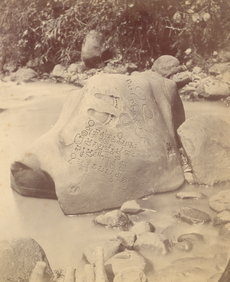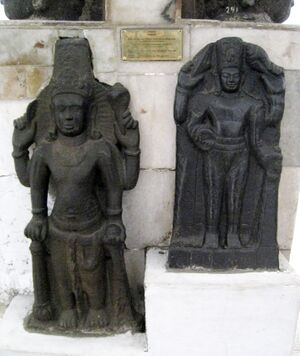تارومانگرا
State of Taruma ᮒᮛᮥᮙᮔᮌᮛ Tarumanagara | |||||||||||||
|---|---|---|---|---|---|---|---|---|---|---|---|---|---|
| 358–669 | |||||||||||||
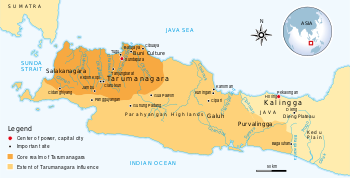 أراضي تارومانگرا | |||||||||||||
| العاصمة | سونداپورا (بين شمال جاكرتا و Bekasi Regency) | ||||||||||||
| اللغات المشتركة | Sundanese, Sanskrit | ||||||||||||
| الدين | Hinduism, Buddhism, Animism, Sunda Wiwitan | ||||||||||||
| الحكومة | Monarchy | ||||||||||||
| Maharaja | |||||||||||||
| التاريخ | |||||||||||||
• تأسست | 358 | ||||||||||||
• غزو سريڤيجايا | 669 | ||||||||||||
| |||||||||||||
| اليوم جزء من | إندونيسيا | ||||||||||||
| هذا المقال هو جزء من سلسلة تاريخ إندونيسيا |
|---|

|
| انظر أيضاً: |
| قبل التاريخ |
| الممالك المبكرة |
| سري ڤيجايا (القرون الثالث إلى الرابع عشر) |
| تاروما نگارا (358-723) |
| سايلندرا (القرنان الثامن والتاسع) |
| مملكة سوندا (669-1579) |
| مملكة مطرم (752–1045) |
| كديري (1045–1221) |
| سنغاساري (1222–1292) |
| ماجاپاهيت (1293–1500) |
| نشأة الدول الإسلامية |
| انتشار الإسلام (1200–1600) |
| سلطنة ملقا (1400–1511) |
| سلطنة دماك (1475–1518) |
| سلطنة آچه (1496–1903) |
| سلطنة بانتن (1526–1813) |
| سلطنة مطرم (1500s to 1700s) |
| الاستعمار الاوروبي |
| البرتغاليون (1512–1850) |
| شركة الهند الشرقية الهولندية (1602–1800) |
| الهند الشرقية الهولندية (1800–1942) |
| بزوغ إندونيسيا |
| الصحوة الوطنية (1899–1942) |
| الاحتلال الياباني (1942–45) |
| إعلان الإستقلال (1945) |
| الثورة الوطنية (1945–1950) |
| إندونيسيا المستقلة |
| الديمقراطية الليبرالية (1950–1957) |
| الديمقراطية المهدية (1957–1965) |
| بداية النظام الجديد (1965–1966) |
| النظام الجديد (1966–1998) |
| عصر الإصلاح (1998–الحاضر) |
| عدّل هذا القالب |
تارومانگرا Tarumanagara أو مملكة تاروما أو مجرد تاروما Taruma هي an early Sundanese Indianised kingdom, located in western Java, whose 5th-century ruler, Purnawarman, produced the earliest known inscriptions in Java, which are estimated to date from around 450 CE.[1]
At least seven stone inscriptions connected to this kingdom were discovered in Western Java area, near Bogor and Jakarta. They are Ciaruteun, Kebon Kopi, Jambu, Pasir Awi, and Muara Cianten inscriptions near Bogor; Tugu inscription near Cilincing in North Jakarta; and Cidanghiang inscription in Lebak village, Munjul district, south of Banten.[2]
الموقع
The inscriptions of Taruma kingdom are the earliest records of Hindu settlements in the western part of the archipelago.[1] The geographical position of coastal West Java, which corresponds to today modern Jakarta, is a commanding region that controls the Sunda Strait. This location is strategic in regard to Sumatra, and also its connection to Asian continent of India and China.
The kingdom was located not far from modern Jakarta, and according to the Tugu inscription Purnawarman apparently built a canal that changed the course of the Cakung River, and drained a coastal area for agriculture and settlement. In his inscriptions, Purnavarman associated himself with Vishnu, and Brahmins ritually secured the hydraulic project.[3] Tarumanagara is believed to have existed between 358 and 669 CE in the Western Java region, in and around modern-day Bogor, Bekasi and Jakarta, which roughly corresponds to modern Greater Jakarta area.
The earliest known written records of Tarumanagara's existence were inscribed in stone inscriptions.[4] Inscribed stone is called prasasti in Indonesian. Numbers of stone inscriptions dated from Tarumanagara period were discovered in Western Java region.
التأريخ
The historiography of the Taruma kingdom were mostly uncovered, acquired and constructed from two main sources; the primary record of the stone inscriptions discovered near present-day Bogor and Jakarta, and Chinese chronicles dated from the Sui and Tang dynasties.
In 1863, Dutch East Indies, a huge boulder of inscribed stone was spotted near Ciampea not far from Buitenzorg (Bogor). The stone inscription was discovered on the river bed of Ciaruteun river, a tributary of Cisadane River. It is today known as the Ciaruteun inscription, dated from the 5th century, written in Vengi letters (used in the Indian Pallava period) and in Sanskrit language. This is the earliest inscription that clearly mentioned the kingdom's name "Tarumanagara".[5] The inscription reports the most famous king of Tarumanagara.
Ciaruteun inscription.[5]
Located nearby is the Kebon Kopi I inscription, also called Telapak Gadjah stone, with an inscription and the engraving of two large elephant footprints. The inscription read: These elephant foot soles, akin to those of the strong Airavata (elephant, which God Indra used to ride), belongs to Tarumanagara King who is successful and full of control.
Not only the stones testify of the existence of King Purnawarman and his Tarumanagara kingdom ,but also Chinese historical sources, since Tarumanagara maintained extended trade and diplomatic relations in the territory stretching between India and China. The Chinese Buddhist Monk Fa Xian reported in his book Fo-kuo-chi(佛國記) (414) that he stayed on the island of Ye-po-ti (耶婆提.Chinese spelling of Javadvipa), most probably the western part of Java island, for six months, from December 412 until May 413. He reported that the Law of Buddha was not much known, but that the Brahmans (Hinduism) flourished, and heretics (animists) too.
Between the period 528 to 669, Tarumanagara sent their embassy to Chinese court.[6] The kingdom was mentioned in the annals of the Sui dynasty, the king of To-lo-mo(possibly 塔鲁纳) (Taruma) has sent diplomatic mission, which arrived in China in 528 and 535. It was mentioned that the kingdom is located far south of China.
The annals of Tang dynasty also mentioned in the year 666 and 669 the envoys of To-lo-mo has visited the court of Tang.[1]
The history of Sunda kingdom and its predecessor (Tarumanagara and Salakanagara) is recorded quite detailed in Pustaka Rajyarajya i Bhumi Nusantara (simply known as Nusantara), a book within Wangsakerta manuscripts collection composed in late 17th century Cirebon. However, currently the Wangsakerta manuscripts are generally discounted as a valid historical source among historians, since this controversial manuscript is suspected as a fraud containing pseudohistory.[7][8]
أصل الاسم
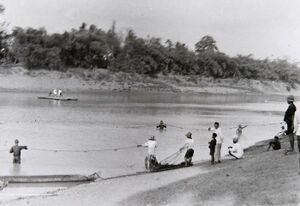
The name Tarumanagara was found in several inscriptions in the Western Java region dated from circa 4th century. The Chinese chronicle also recorded the name To-lo-ma or To-lo-mo which suggest the Chinese pronunciation of "Taruma". Tarumanagara means the kingdom of Taruma. The name "Taruma" itself is connected to the Citarum River of West Java.[1] In Sundanese language, ci means water or river while tarum means indigo plant. Tarum is local name of indigo plant that used to create the indigo dyeing pigment.[9]
التاريخ
Around 400 BCE to 100 CE, a prehistoric clay pottery culture was flourished in northern coastal Western Java. This clay pottery culture is identified as Buni culture, named after its first discovered archaeological site, Buni village in Babelan, Bekasi, east of Jakarta. Archaeologist suggests that this culture was the predecessor of Taruma kingdom. This is affirmative regarding its connection to Batujaya archaeological site.[10] The ancient society that supported the Buni culture was Indianised; absorbing Hindu influences from India, and establishing early Hindu polity in Java.
According to the book Geographike Hyphegesis written in 2nd-century Roman Empire, a Greek geographer Claudius Ptolemaeus mentioned about countries in the far east of the known world then. Among others is a city called Argyre on the western edge of the Iabadiou island. Iabadiou can be equated in Sanskrit as Yawadwipa, which corresponds to the island of Java. The name argyre means "silver", while in local Indonesian and Sundanese language, silver is called perak, which sound similar to the Merak port town on the western edge of Java.[11]
الحكام الأوائل
According to the book Nusantara, Maharshi Rajadirajaguru Jayasingawarman founded the Tarumanagara kingdom in 358. Jayasingawarman originated from Salankayana, Andhra Pradesh, India that collapsed after the invasion of Samudragupta from Gupta Empire. After re-settling in Western Java, he married a Sundanese princess daughter of King Dewawarman VIII of Salakanagara.[12] He died in 382 and was buried at the bank of Kali Gomati river (present-day Bekasi city). His son, Dharmayawarman ruled from 382 to 395. His burial site is at Chandrabaga river. His grandson Purnawarman was the third king of Tarumanagara and reigned from 395 to 434.
عصر پورناوارمان
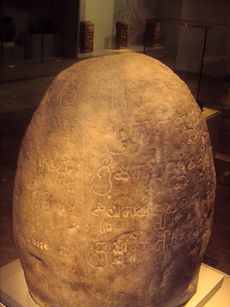
Book Nusantara, parwa II sarga 3 (page 159 – 162) notes that under the reign of King Purnawarman, Tarumanagara held control over 48 small kingdoms with area stretching from Salakanagara or Rajatapura to Purwalingga (current city of Purbalingga in Central Java Province). Traditionally Cipamali river (Brebes river) was the border between Sunda and Java.
In 397, King Purnawarman established a new capital city for the kingdom, located near to a beach, called Sunda Pura meaning Holy Town or Pure Town. Thus, word "Sunda" was introduced for the first time by King Purnawarman in 397. Sunda Pura could have been near present-day Kampung Tugu (North Jakarta), or near present-day Bekasi. He left seven memorial stones with inscriptions bearing his name spread across current Banten and West Java provinces. The Tugu inscription, which is a few years older than the Ciaruteun inscription, is considered the oldest of all the inscriptions.
There are more stones with inscriptions from the time of king Purnawarman, some close to Bogor city. They are Muara Cianten inscription, Pasir Awi inscription, Cidanghiang inscription, and Jambu inscription. Cidanghiang inscription (sits further to the west at Lebak in the Pandeglang area), consisting of two lines, proclaiming Purnawarman as the standard for rulers around the world. Jambu inscription, with a two-line inscription in Pallava/Sanskrit, bears the large footprints of the king. The inscription translates as:
The name of the king who is famous of faithfully executing his duties and who is incomparable (peerless) is Sri Purnawarman who reigns Taruma. His armour cannot be penetrated by the arrows of his enemies. The prints of the foot soles belong to him who was always successful to destroy the fortresses of his enemies, and was always charitable and gave honorable receptions to those who are loyal to him and hostile to his enemies.[13]
الملوك بعد پورناوارمان
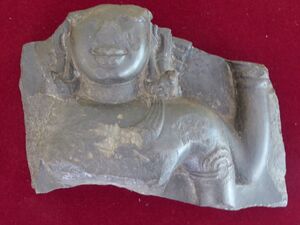
Purnawarman probably is the most well-known king of Tarumanagara because he produced quite a number of well documented inscriptions. The records about Tarumanagara's later kings were scarce and obscure, most were known from later manuscripts and local traditions.
Later series of Tarumanagara kings are only known from their names, all bears the name warman (Sanskrit: varman means "shield" or "protector") which suggests that all of them belongs in the same dynasty.
A rather detailed information was known about King Suryawarman that ruled from 535 to 561. King Suryawarman established a new capital city eastward and left Sundapura and its communities to preserve their own order. Then, Sundapura become a new smaller kingdom called Sunda Sambawa which was under control of Tarumanagara. Before the Suryavarman reigned Tarumanagara, Manikmaya, his son in-law, in 526, left Sundapura went southeastward and established Kendan, a new kingdom currently in Nagreg area, near modern Garut city.
Kertawarman ruled c. 561 to 628. During this period the grandson of Manikmaya, Wretikandayun, in 612, established Galuh Kingdom, southeast of current Garut with its capital city located in Banjar Pataruman. Kertawarman's successor, King Linggawarman ruled from 628 to 650, he however produced no male heir. Linggawarman's eldest daughter Manasih, married to Tarusbawa, ruler of Sunda Sembawa. While the second daughter of King Linggawarman, Princess Sobakancana, married Dapunta Hyang Sri Jayanasa, who later established the Srivijaya kingdom.
الانحدار
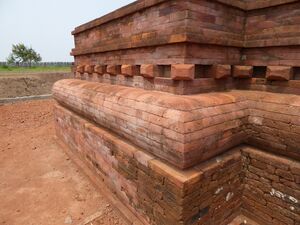
King Tarusbawa of Sunda Sembawa (Tarumanagara's vassal) married to Manasih, the eldest daughter of Linggawarman, thus made him the successor of Linggawarman. Tarusbawa however was more interested to reestablish his own home kingdom Sundapura, as his new capital and abandoning Tarumanagara's capital.
This event was made as a reason by king Wretikandayun (monarchic founder of Galuh) to dissociate Galuh from Tarumanagara. He demanded King Tarusbawa to divide Tarumanagara territory into two parts. Galuh got a support from Kalingga kingdom (the first kingdom in Central Java) to separate from Tarumanagara because Galuh and Kalingga had made an alliance through dynastic marriage; a son of King Wretikandayun married Parwati (a daughter of Queen Shima) from Kalingga and Sana alias Bratasenawa alias Sena (a grandson of King Wretikandayun) married Sanaha (a granddaughter of Queen Sima). In a weak position and wishing to avoid civil war, the young King Tarusbawa accepted the request of old King Wretikandayun.
After 670, Tarumanagara was divided into two kingdoms: Sunda Kingdom and Galuh Kingdom with the Citarum river as the boundary. Then Galuh Kingdom comprised many vassal kingdoms which covered areas of present-day West and present-day Central Java Provinces.
According to 7th century Kota Kapur inscription, Srivijaya, centred in today Palembang, South Sumatra, launched a military expedition against Bhumi Jawa, the period coincides with the decline of Tarumanagara. It is very likely that Tarumanagara kingdom was attacked and defeated by Srivijaya around 686.[1] The pretext behind Srivijayan campaign against Tarumanagara was obscure, however it was probably because of Jayanasa's own claim to Tarumanagara's throne, afterall his wife, Sobakancana, is the daughter of Linggawarman, the late king of Tarumanagara. After this naval invasion, Tarumanegara's influence began to decline.
Devastated by Srivijayan invasion, King Tarusbawa then moved further inland to find a refuge in the south and established a new capital near the Cipakancilan river upstream (today in modern Bogor). It seems that he left the coastal areas of port of Sunda and Kalapa (today coastal areas of modern Banten and Jakarta) under Srivijayan mandala's control. This capital centuries later became the city of Pakuan Pajajaran (or shortly called Pakuan or Pajajaran). King Tarusbawa becomes the predecessor of Sunda kings.
الاقتصاد
The Chinese source mentioned about the product being traded in Taruma, which suggests the population made a living in hunting, mining, fishing, trade and shipping; aside of agriculture and farming sector. The commodities being traded in Taruma was specific hunting products, such as rhino horn, ivory and turtle shell. Gold and silver were traded too, which suggest the active mining sector. The Tugu inscription mentioned about the construction of hydraulic projects through the construction canals. This irrigation project suggest that the area of northern West Java and Jakarta was transformed into irrigated rice paddies. The canals also meant as a water management to prevent flooding that often hit the capital of Tarumanagara.[11]
الدين
According to Chinese source written by Faxian, a Buddhist pilgrim that visited Tarumanagara in his journey to India; in the early 5th century there were three kinds of religions adhered by the population of Taruma kingdom; i.e. Buddhism just as adhered by Faxian himself, Hinduism, and a religion which he described as "impure" religion.[11] The so-called "impure" religion probably refer to native animism beliefs practiced by local population prior of Hindu-Buddhist influence.[11]
Hinduism was the main religion in Tarumanagara kingdom, at least among its elites ruling class. This is based on several inscriptions dated from Tarumanagara period. For example, Tugu inscription mentioned that the father of Purnawarman is titled as Rajadhiraja Guru has dug the canal in Chandrabhaga. Purnawarman himself credited for the construction of Gomati canal. The inscription also mentioned that King Purnawarman donated a thousand cows as gifts for Brahmins. These rituals demonstrate the Vedic Hinduism practice.[11] The Ciaruteun inscription also demonstrated Vedic tradition; by equating the print of Purnawarman's soles with the foot of Hindu god Vishnu. Both Ciaruteun and Cidanghiang inscription mention vikkranta, which rever to Trivikrama or the "three steps" performed by of Vishnu avatar, Vamana. In Jambu inscription, Purnavarman was equated with Indra and Surya.[11] The Vishnu statues from Cibuaya dated from 7th century, also the Rajarsi statue discovered in Jakarta, also testified of Hindu prevalence in Tarumanagara.
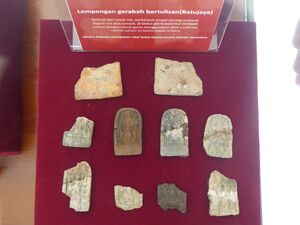
Buddhism did practiced in Tarumanagara as reported by Faxian in early 5th century. However, he said there were only a few Buddhists in the kingdom. Near the north coast of West Java, earth mounds called by locals as unur or hunur were discovered in 1960s. The excavated earth mounds in Batujaya archaeological site revealed that these earth mounds were actually red brick structures, either Candi (temples) or stupas. Numbers of Buddhist votive tablets were discovered near Blandongan temple in Batujaya archaeological site, confirming Buddhist background of the site, and the faith was indeed practiced in Tarumanagara.[11] The stratigraphy of Blandongan temple revealed several layers of cultures dated between 2nd century to 12th century. This means after the fall of Tarumanagara, the Buddhist site of Batujaya was still actively used. Which means Batujaya temples was used between 4th and 7th century during Tarumanagara period; and continued well after 7th century to 10th century, possibly under Srivijaya suzerainty.
الذكرى
Unlike its successor; the Sunda kingdom that still remembered in Pantun Sunda; the oral tradition of local Sundanese—Tarumanagara was completely forgotten among local population in West Java. It was not until late 19th century when archaeologist and historian finally deciphered the stone inscriptions discovered near Buitenzorg and Batavia. The discovery and study of numerous Tarumanagara inscriptions; especially those issued by King Purnawarman, had uncover that this kingdom was indeed the earliest Hindu polity in western Indonesia. Together with Kutai and Kalingga, Tarumanagara is remembered as a pioneer states that started the historical period of Indonesia.[2]
Tarumanagara is especially important as the historical identity for the city of Bekasi and its surrounding area, since local historians believe that the capital of Tarumanagara was located in or around the present day Bekasi city. The name Chandrabhaga mentioned in Tarumanaga inscription believed was the ancient name of Bekasi—from Chandrabhaga (Sanskrit for "moon river"), changed to Bhagasasi and finally corrupted into its present form as Bekasi.[14]
Tarumanagara kingdom also has become the name for Tarumanagara University, a private university based in Jakarta, established in 1959.[15]
قائمة الحكام
- Jayasingawarman, 358 - 382
- Dharmayawarman, 382 to 395. His burial site is at Chandrabaga river.
- Purnawarman, 395 - 434. Produced large numbers of inscriptions
- Wisnuwarman, 434 - 455
- Indrawarman, 455 - 515
- Candrawarman, 515 - 535
- Suryawarman, 535 - 561. Established new capital, left old capital of Sundapura, a new settlement was established inland in Kendan near modern Garut
- Kertawarman, 561 - 628. Establishment of Tarumanagara's colony Galuh Kingdom in 612 by Wretikandayun, the grandson of Manikmaya.
- Linggawarman, 628 - 650. Marriage arrangement with Dapunta Hyang Sri Jayanasa of Srivijaya and the second daughter of King Linggawarman, Princess Sobakancana.
- Tarusbawa, c. 670 - 690. Disintegration of Tarumanagara into Sunda Kingdom and Galuh Kingdom and independence of Galuh. Srivijayan invasion according to Kota Kapur inscription.
انظر أيضاً
الهامش
- ^ أ ب ت ث ج Coedès, George (1968). Walter F. Vella (ed.). The Indianized States of Southeast Asia (PDF). trans.Susan Brown Cowing. University of Hawaii Press. ISBN 978-0-8248-0368-1.
- ^ أ ب R. Soekmono (1988) [1973]. Pengantar Sejarah Kebudayaan Indonesia 2, 2nd ed (in الإندونيسية) (5th reprint ed.). Yogyakarta: Penerbit Kanisius.
- ^ Mary Somers Heidhues (2000). Southeast Asia: A Concise History. London: Thames and Hudson. p. 45 and 63..
- ^ Bogor City: Bogor Inscription
- ^ أ ب Zahorka, Herwig (2007). The Sunda Kingdoms of West Java, From Tarumanagara to Pakuan Pajajaran with the Royal Center of Bogor. Jakarta: Yayasan Cipta Loka Caraka.
- ^ Munoz, Paul Michel (2006). Early Kingdoms of the Indonesian Archipelago and the Malay Peninsula. National Book Network. ISBN 9789814155670.
- ^ Lubis, Nina H. (2012-08-03). "Kontroversi Tentang Naskah Wangsakerta". Humaniora (in الإندونيسية). 14 (1): 20–26. doi:10.22146/jh.v14i1.741 (inactive 31 October 2021). ISSN 2302-9269.
{{cite journal}}: CS1 maint: DOI inactive as of أكتوبر 2021 (link) - ^ "Mengungkap Kontroversi Naskah Wangsakerta - Radar Cirebon". Radar Cirebon (in الإندونيسية). 2013-12-14. Retrieved 2018-06-03.
- ^ "Citarum dalam Perspektif Sejarah" (in الإندونيسية). National Geographic Indonesia.
- ^ "Batujaya Temple complex listed as national cultural heritage". The Jakarta Post (in الإنجليزية). 8 April 2019. Retrieved 2020-10-26.
- ^ أ ب ت ث ج ح خ Marwati Djoened Poesponegoro; Nugroho Notosusanto (2008). Sejarah Nasional Indonesia: Zaman Kuno (in الإندونيسية). Balai Pustaka. ISBN 978-9794074084. OCLC 318053182.
- ^ Garis Waktu Sejarah Nusantara
- ^ "Sistem Registrasi Nasional Cagar Budaya". cagarbudaya.kemdikbud.go.id. Retrieved 2020-08-02.
- ^ Bekasi, Pikiran Rakyat (29 January 2020). "Jadi Ibu Kota Kerajaan Tarumanegara, Simak Sejarah Bekasi dari Zaman Kerajaan hingga Penjajahan - Pikiran Rakyat Bekasi". Pikiran Rakyat (in الإندونيسية). Retrieved 2020-10-26.
- ^ "History of Universitas Tarumanagara". untar.ac.id. Retrieved 2020-10-26.
ببليوگرافيا
- Book Nusantara, Chapter II, Sub-chapter 3 (page 159 – 162)
- Edi S. Ekadjati, Kebudayaan Sunda Zaman Pajajaran, Jilid 2, Pustaka Jaya, 2005
- (1915, "Maharadja Cri Djajabhoepathi, Soenda’s Oudst Bekende Vorst", TBG, 57. Batavia: BGKW, page 201–219)
- CS1 الإندونيسية-language sources (id)
- CS1 maint: DOI inactive as of أكتوبر 2021
- Pages using gadget WikiMiniAtlas
- Articles containing سوندائية-language text
- Former country articles categorised by government type
- Pages with empty portal template
- Coordinates on Wikidata
- تارومانگرا
- دول قبل الاستعمار في إندونيسيا
- Hindu Buddhist states in Indonesia
- Sundanese culture
- History of West Java
